#Common Bullfinch
Text


A colourful rounding
#photographers on tumblr#original photography#bird photography#birding#iland#common bullfinch#Gimpel#Dompfaff#Hamburg
541 notes
·
View notes
Text

Reference photo by Francis C. Franklin
#bullfinch#common bullfinch#eurasian bullfinch#pyrrhula pyrrhula#pyrrhula#carduelinae#fringillidae#passeriformes#bird#birb#bird art#birb art#ornithology#art#digital art#artists on tumblr#tw eyestrain#cw eyestrain#wauk wauk
23 notes
·
View notes
Text
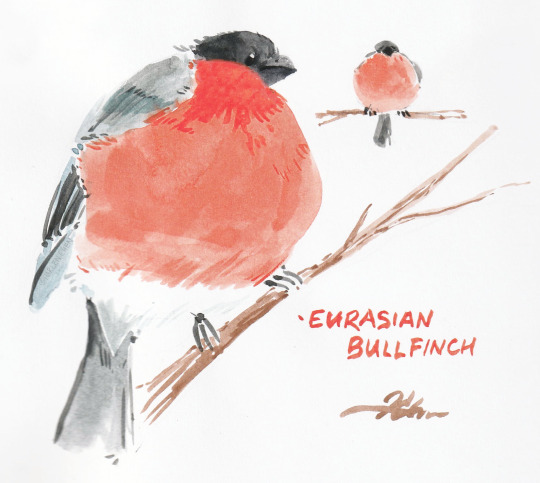
Eurasian Bullfinch for Fat Bird Friday
» Etsy • Various Links «
© Harlen Chen
#Eurasian Bullfinch#eurasian bullfinch male#common bullfinch#bullfinch#finch#watercolour#traditional art#bird#fat bird#fbf#fat bird friday#fluffy#round#borb#chonk#chunk#art#illustration#🐦#burb#birb#HC#regular content#2023#animal#animals#rotund
103 notes
·
View notes
Text
Creature Awaits #246
Each week I plan to feature an amazing creature, admiring God's fantastic artistry. Hopefully it’ll brighten someone’s day to see something new and interesting if they haven’t seen it before. : )
As the Pantone color of the year is "Peach Fuzz", so we'll dive into the second month of this relatively new year by featuring creatures of this cozy, comforting color. : )

(Beautiful photography by Luiz Lapa (CC BY 2.0 Deed))
The Eurasian Bullfinch
Scientific Name: Pyrrhula pyrrhula
Region: Throughout Europe and temperate regions across Asia
Size: About 6" (~15.2cm) tall
Interesting Notes: In many English-speaking parts of Europe, this is bright and beautiful bird is simply known as a Bullfinch, as it was the first bird to be given that name. There are now a handful of both Old and New World bullfinches. The peach belly and grey back only appears on the male, these parts are a soft, pale brown on females, though the black markings remain in similar locations.
#creatureawaits#beautiful birds#beautiful animals#cute animals#Eurasian Bullfinch#Bullfinch#Common Bullfinch#Pyrrhula pyrrhula
1 note
·
View note
Text



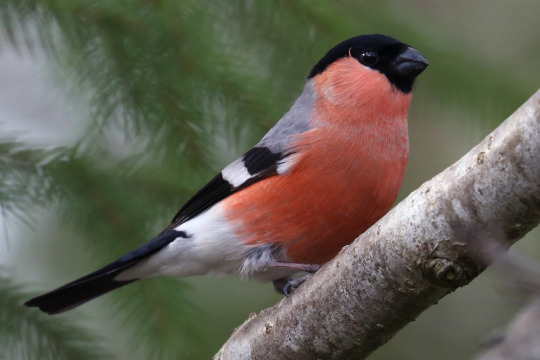

Yellowhammer/gulsparv, Western jackdaw/kaja, Chaffinch/bofink, Bullfinch/domherre and Blue tit/blåmes. Värmland, Sweden (April 19, 2019).
285 notes
·
View notes
Text

Happy Thneedmas, @theonceler!
sending ya boy a few flying symbols of the winter holidays to infuse his grump self with some frosty cheer 🐦✨
#McDoodles#monsterler#thneedmas#don't think eurasian bullfinches are a common sight outside of. well. eurasia. but im still chucking them over at him#get festive with it monster m'dude
63 notes
·
View notes
Text
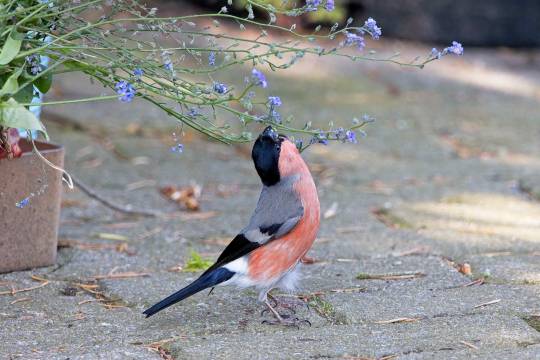



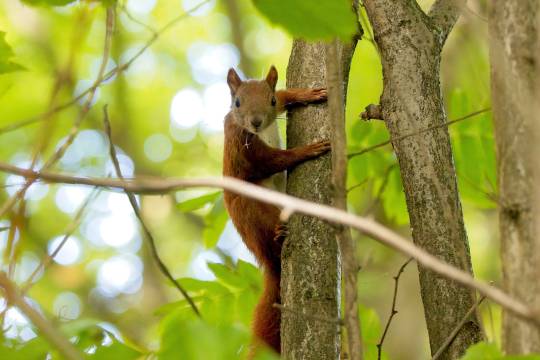




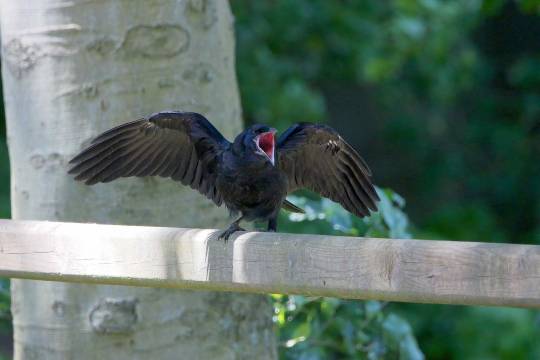
My personal highlights - 2023 - part 6:
The birds I see when I am visiting my father. There is a lake nearby and a large colony of rooks and of course the birds and squirrels in the garden, plus this year hornets decided to use a nesting box.
#bullfinch#common merganser#grey heron#eurasian squirrel#rook#european hornets#woodpigeon#carrion crow#birds#gimpel#gänsesäger#graureiher#eichhörnchen#saatkrähe#hornisse#ringeltaube#rabenkrähe
28 notes
·
View notes
Text

The Child's Picture Scrap Book. Containing Upwards of Four Hundred Illustrations by John Gilbert, J. D. Watson, Wolf, Coleman, etc. 1865.
Internet Archive
74 notes
·
View notes
Text



I made three bird paintings to hang on my wall. Don't want to look at people, but can look at birds all day.
#traditional illustration#traditional art#traditional painting#birds#bird art#common kingfisher#blue tit#eurasian bullfinch#watercolor art#mixedmediaart#nature art#artists on tumblr#artists of tumblr#watercolor painting#wildlife art
5 notes
·
View notes
Text
I was supposed to help plant banana trees today but the land is too steep for my clumsy skin to walk down by myself so i ended up bird watching instead
#i saw some antillean bullfinches some grey kingbirds a common ground dove aand there was an egret for some reason?#and a mongoose?!
0 notes
Note
Hey do you have any literature recommendations for people who want to broaden their knowledge on the classics and Greek/Roman myths without taking university courses?
So like for people (such as myself) who have read Bullfinch's Myths of Greece and Rome and Edith Hamilton's Mythology: Timeless Tales of Gods and Heroes but want to deepen their knowledge and maybe go to intermediate level type stuff. Or whatever the level above the mentioned literature is.
Well those two books are quite old and skip over quite a few things. Both are very important to our culture, historically, but I'd recommend reading through some more modern popular retellings like Stephen Fry's Mythos series if you're looking for pure entertainment and a dummy's guide to Greek myths.
The Penguin Dictionary of Classical Mythology is a useful reference book if you have difficulty keeping track of all these names and whatnot. It's just a reference book but you know. Having a reference book handy is quite useful. I personally prefer reference books when it comes to checking stuff when I'm doing mythology things anyways. They're generally more organized than the internet.
If you're looking for entertaining retellings of less popular myths, I'd actually recommend going to videos and podcasts for that. YouTubers like MonarchsFactory, Overly Sarcastic Productions, Jake Doubleyoo, and Mythology & Fiction Explained are all people who do a lot of research themselves on the myths they retell and I would recommend all of them to basically anybody. As far as podcasts go, Mythology & Fiction Explained has a podcast version and Let's Talk About Myths, Baby! is a very informative podcast that talks about sources for the myths and has interviews with experts on the subjects. It's also a podcast that is specifically Greco-Roman based.
As far as doing slightly more in-depth research, I cannot recommend theoi.com enough. I really can't. It has overviews of the most common myths, it has pages about god and hero cults, it cites it's sources and has an online library of translated texts. It's just really good. Go clicking around it for a while. It's a lot of fun if you're into that sort of thing.
As far as primary sources for myths go, there's a few places you could start. The Iliad, perhaps. The most recent English translation is by Caroline Alexander but I personally prefer Stanley Lombardo's translation. The Odyssey is a more accessible read in my opinion if you're not used to reading epic poetry. Emily Wilson's translation is especially accessible, written in iambic pentameter and generally replicating Homer's simple conversational language.
The third traditional entrance into the epic cycle of the surviving literature is the Aeneid. The newest translation of that is by Shadi Bartsch, which is pretty good, but it reads more like prose than poetry. Would still highly recommend it though. Robert Fitzgerald's translation is also good.
If you wanna get fancy you can read the Post-Homerica which attempts to bridge the gap between the Iliad and the Odyssey. It's not often read but it's one of the latest pagan sources we have from people who still practiced ancient Greek religion.
If you want a collection of short stories from ancient times, Ovid's your guy. Metamorphosis is specifically Roman and specifically Ovid's fanfiction, but it's also a valid primary resource and Ovid generally views women as people. What a concept!
Though I think the absolute best overview from ancient times itself is The Library aka Biblioteca by pseudo-apollodorus. Doesn't matter what translation you get. The prose is simple to the point where it's difficult to screw it up. Not artistic at all. It is, quite simply, a guy from ancient times trying to write down the mythological history of the world as he knew it. It has a bunch of summaries of myths in it, and most modern printings also have a table of contents so you can essentially use it as a reference book or a cheat sheet. I love it.
The Homeric Hymns weren't actually written by Homer but that's what they're called anyways. They're a lovely bit of poetry because, well, they were originally hymns. They've got some of the earliest full tellings of the Hades and Persephone story and the birth of Hermes in them. They also provide an insight into how ancient people who were most devoted to these gods viewed them. Go read the Homeric Hymns. They're lovely. You can buy the Michael Crudden translation or you can read a public domain translation online. I don't care. Just read them.
If you're into tedious lists, the next place I'd recommend you go after you read all the fun stuff is Hesiod's Theogony. Hesiod, the red pill douchebag of the ancient world, decided he was gonna write down the genealogy of all the Greek gods. That means lists. I'm not exaggerating. Be prepared for a lot of lists. But this work also has the earliest and one of the most complete versions of the story of Pandora, the creation of humans, and the most popular version of the Greek creation myth. So, it's very useful. If you can take all the lists.
The Argonautica aka the voyage of the argo by Apollonius of Rhodes, is also here. That is also a thing you can read. About the golden fleece and whatnot. And Jason. You know Jason. We all hate Jason.
Greek theatre also provides a good overview of specific myths. The three theben plays, Medea, the Bacche, etc. We've only got thirty-something surviving plays in their entirety so like... look up the list. Find one that looks interesting. Read it. Find a performance of it online, maybe. They're good.
If you want to dive into the mythology as a religion that was practiced, Greek Religion by Walter Burkurt and Ancient Greek Cults: A Guide by Jennifer Larson are pretty good books on the topic and often used as textbooks in college courses.
If you wanna get meta and get a feel for what the general public today thinks about Greek myths and what the average person that's sort of knowledgeable about Greek myths knows, the books you already mentioned are good. That's what people usually read. In addition to those, most people's intro to Greek myths generally involves The Complete World of Greek Mythology by Richard Buxton, D’Aulaires’ Book of Greek Myths by Ingri and Edgar Parin d’Aulaire, or The Percy Jackson series.
I've been flipping through the big stacks of mythology books I keep on my table trying to remember if I've forgotten anything but I don't think I have so, yeah. Hope this helps. There's no correct starting point here. Once you get started there's a nearly endless void of complications and scholarship you can fall down that you'll never reach the bottom of. This post is basically just a guide to the tip of the iceberg.
#mythology#greek mythology#roman mythology#reference#roman said a thing#classical mythology#classics#classics reference#mythology for beginners#mythology reference#greco-roman
385 notes
·
View notes
Note
hi! i'm really loving icarus, you're a wonderful writer! but i just had a quick question. i love the flock graphics, and they're super helpful! would it be possible for you to maybe list the species of birds for the main 'characters' of the story as well? you don't have to post example photos or anything crazy, but i think just a list like that would be helpful too. sometimes i forget who has what kind of wings, and i think having a list so i can google image the bird would be great.
if that's not something you want to do or don't have time to do or something, no worries!! i really appreciate you taking the time to write icarus in the first place <3
Oof I might as well do a general guide! I never thought a maxiel wingfic would spawn so many specific wing allocations but here's the general list:
Paddock wings in Icarus:
Current grid:
Daniel Ricciardo - Scarlet Macaw (colourful, nimble flyers)
Max Verstappen - Peregrine Falcon (raw speed, inherited from his mother)
Sergio Perez -Crested Caracara (a type of mexican bird of prey)
Lewis Hamilton - Greater Bird of Paradise (beautiful wing plumes, lovely singer)
George Russell - Blue swallow (beautiful metallic-blue feathers, scream like madmen when they fly)
Carlos Sainz - Spanish Imperial Eagle (white epaulets, very regal)
Charles Leclerc - White Dove (need I say more? Perfect white wings, exploited because they're pretty but so intelligent in pathfinding)
Lando Norris - Lucifer Hummingbird (Small, colourful, likes to hover in place)
Oscar Piastri - Little Lorikeet (One of the smaller types of Australian parrot. Very cute)
Yuki Tsunoda - Japanese Long-tailed tit (Photos should be self explanatory. They fly like ballistic missiles)
Alexander Albon - Crested Fireback (National bird of Thailand. Beautiful dark blue and fiery plumage)
Logan - Blue Jay (Commonly found in Florida. Blue, like Logan's current posting, and his eyes)
Pierre Gasly - Osprey (A bird of prey often found near coasts along the European shoreline, and Pierre is from Normandy)
Esteban Ocon - Black Stork (Tall, gangly, also migrates through France)
Fernando Alonso - Kestrel (a type of small bird of prey, hunts by biding their time and waiting then divebombing)
Lance Stroll - Snowy Owl (Lance is cuddly ok and I didn't want to make him a Canadian goose because that's his dad)
Valtteri Bottas - Bullfinch (Look it up. The picture is self-explanatory. The manliest of men)
Zhou Guanyu - Chinese Red-Crowned Crane (A crowned crane for the champion of the universe, as translates his name)
Kevin Magnussen - Raven (Viking. quoth the raven.)
Nico Hulkenberg - Crow (he keeps coming back. As wily as many of their bird counterparts but has a bad rep for being a bad omen)
Retired drivers or drivers not currently on the grid:
Sebastian Vettel - Swiftlet (Extremely good fliers, reaching up to 160km/h and pulls insane G-forces)
Mick Schumacher - European robin (Very cute. Universally liked. Same wings as his father)
Nico Rosberg - Eurasian Sparrowhawk (a bird of prey that hunts by ambushing before a high-speed, agile chase)
Jenson Button - Northern Harrier (hunts in a high-speed flight close to the ground, exceptionally good listeners)
Mark Webber - Cassowary (look up a photo. Just look at it.)
Kimi Raikkonen - Giant Albatross (King of gives no shits, flies very long distances without a care)
David Coulthard - Bush-Stone Curlew (White trousers!)
Romain Grosjean - Red-tailed Hawk (I chose the bird of prey that could best mesh with the phoenix metaphor)
Antonio Giovannazi - White-spotted Starling (Very pretty plumage)
Daniil Kyvat - Great Bustard (I honestly don't remember why. Distributes in Russia)
Nyck De Vries - Common European Sparrow (Small. Commonly found. Unfortunately often hunted)
Nikita Mazepin - Flamingo (Need I say more)
Sir Jackie Stewart - (Clipped) Merlin Wings (Extremely fast Scottish bird of prey. In-fic, Jackie was one of the generation of drivers that clipped their wings, permanently robbing them of flight)
Team Principals and people in the paddock:
Toto Wolff - Black Swan (self-explanatory)
Christian Horner - Golden Eagle (A bit pompous. Matches his hair)
James Vowles - Magpie (Utterly clever, not from any particular prestige)
Fred Vasseur - Partridge (Affable. Cuddly.)
Guenther Steiner - Shoebill (self-explanatory, look up a photo)
Cyril Abiteboul - Eagle Owl (something about his face is very Eagle Owl)
Micheal Italiano - Kookaburra (laughs when they shouldn't)
Zak Brown - Chicken (self-explanatory. Literally and metaphorically)
Andreas (mclaren) - Common Quail (short lifespan)
Mattia Binotto - Pigeon (wants to be as pretty and loved as Charles. Is a public nuisance instead)
Otmar sznafnauer - Peacock (Struts around, can't really fly)
Resident Bastard:
Jos Verstappen - Cuckoo (Cuckoos are brood parasites, and lay their eggs in nests of birds of other species'. The cuckoo parent therefore does nothing while other birds raise their young)
#I've probably missed a couple minor characters so if anyone has any questions feel free to drop a reply and I'll answer#f1#f1 wingfic#f1 wing au#icarus#my post#writing#fanfic
33 notes
·
View notes
Text

Bullfinch, reference photo was from a few months back at the nature reserve
#bullfinch#common bullfinch#eurasian bullfinch#finch#pyrrhula pyrrhula#pyrrhula#carduelinae#fringillidae#passeriformes#bird#birb#bird art#art#digital art#artists on tumblr#tw eyestrain#cw eyestrain#wauk wauk
19 notes
·
View notes
Text
Week of 21APR2024 Answers

Answers hidden under the cut.
155 - Great Kiskadee by @nohriantomatoes
156 - Fork-tailed Sunbird by @casperwyomingxer
157 - Least Sandpiper by @weremars
158 - Common Grackle by Anon
159 - Common Loon by @pooksbedamned
160 - Yellowhammer by @ascendeddragonsage
161 -Eurasian Bullfinch by @benidryl
How many birds did you get right? Consider adding correct birds to your WTB Life List!
As always, birding is a cooperative experience. Help your fellow birders out by discussing key features that help identity and distinguish a bird in the notes.
Finally, let's give a feathery thank you to this week's submitters.

Keep the game alive! Submit a bird HERE
20 notes
·
View notes
Text





Its also the end of #nationalhedgerowweek did you know that our Hedgerows support 130 Biodiversity Action Plan species amongst those are lots of Lichens and Moths.
Theres also a fair amount of Birds as youd imagine.
Dunnock, House Sparrow, Starling, Bullfinch, Lesser Redpoll and Tree Sparrow are all species which rely on hedgerows for feeding and nesting.
But its not just Birds, Reptiles and Amphibians are also reliant on hedgerows as fantastic corridors away from the eyes of predators.
Common Lizard, Common Toad and Slow Worms are often discovered when carrying out important maintenance.
Theres also other insects that need hedgerows to thrive.
Stag Beetles, Brown Hairstreak and Brown Banded Carder Bee require hedgerows. However the Carder Bee is found exclusively in Coastal regions of England and Wales and the Hairstreak sadly only to small pockets of locations across southern and western England and Wales.
And lastly Mammals, obviously there's the Hedgehogs but lots of Bat species use them for hunting grounds sweeping up and down the clearings surrounded them and even roosting!
(Stag Beetles are from Europe, Brown Hairstreak is a Bred specimen from 1979 and Brown Banded Carder Bee is a from 2015, Slow worm was gifted from Birmingham in 2023 none of which were collected by me)
12/05/24
#vulture culture uk#vulture culture#oddities#taxidermy#bones#skull#skull collecting#animal skull#curiosities#national hedgerow week
16 notes
·
View notes
Text



Chaffinch/bofink, Blue tit/blåmes and Bullfinch/domherre. Värmland, Sweden (April 15, 2024).
297 notes
·
View notes